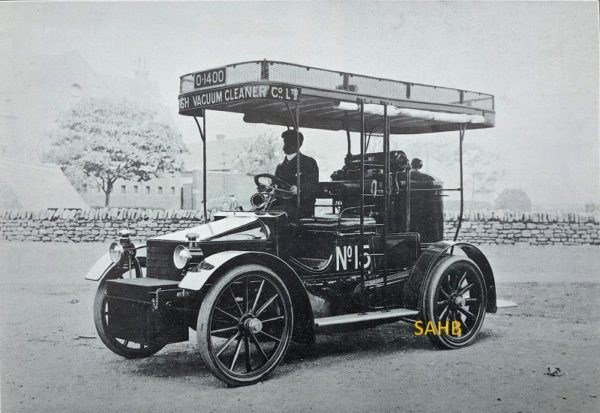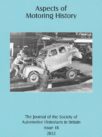
If you wished to keep your house or office clean in the early 20th century you would be unable to find a small, powerful portable vacuum cleaner. Instead, you would call upon the services of a vacuum cleaning company. The equipment in our Snapshot was owned and operated by one of the first of these companies: the British Vacuum Cleaner Co., Ltd. It was based on a modified Wolseley.
One of the first manual vacuum cleaners was invented in 1860 by Daniel Hess in America. Powered cleaners arrived in the late 19th century but these used some method of blowing. A breakthrough came in 1901 when the British engineer Hubert Cecil Booth saw a demonstration of one of these blowing devices and thought that a far better solution would be to reverse the operation. He created a large horse-drawn device powered by an internal combustion engine, nicknamed “Puffing Billy.”
Booth is credited with inventing the term “vacuum cleaner”. He did not sell his machines but set up the British Vacuum Cleaner Company to sell cleaning services, with bright red vans operated by uniformed men who would pass long hoses into a building to reach every room. One of Booth’s machines was used to clean the carpets of Westminster Abbey before Edward VII’s coronation in 1901. By 1903 wealthy society ladies were throwing ‘vacuum cleaner parties’ where guests sipped tea and lifted their feet for the uniformed operators to vacuum the carpet.
Some small details are known of the Wolseley whose chassis formed the basis for the van we see here. To quote a contemporary journal, it had a ‘standard 12 h.p. horizontal engine fixed in the usual position in the chassis’, but its normal pressed steel frame was replaced by one of heavy channel steel. Stronger axles and springs were fitted at front and rear to cope with the 3-ton total weight of the vehicle, its cleaning equipment and a four-man team. A very large radiator was fitted with an engine driven fan, to allow the equipment to run for long periods with the vehicle stationary, without overheating the engine.
The strong canopy with its wire surround was designed to carry the hoses and other equipment, and just behind the driver’s head can be seen the engine exhaust that was deliberately taken up through the canopy to emit its fumes to the open air. In the words of the report: ‘This obviates all danger of objectionable smell when the car is standing outside a private house in operation.’
These large machines were eventually replaced by the portable electric vacuum cleaner. The first one was developed in 1907 by James Murray Spangler in America, who sold the patent in 1908 to a leather goods manufacturer, William Henry Hoover. The rest is history.







Sorry I missed this earlier! Your description is spot-on but I can add that the chassis number was A16 and it was delivered from Wolseley in chassis form on 28 June 1904. It was featured in the Motor Car Journal for 15 July 1905. It was the only Wolseley fitted out as a mobile vacuum cleaner; the British Vacuum Cleaner Company used a variety of makes of cars.